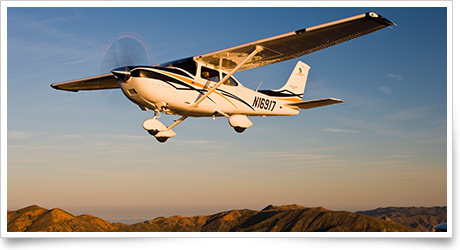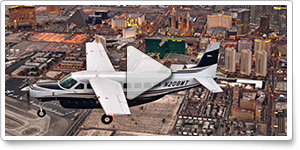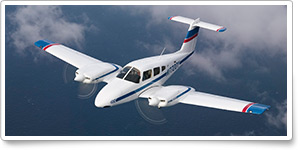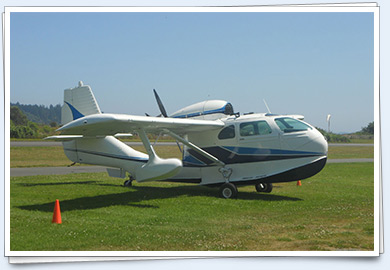| ||||||
| Hedging the heat |
| |||||
| Attention AirVenture attendees: Come to the AOPA Tent and ask how to get a free hat, win gift cards, and fly in a simulator. | ||||||||||||||||||||||||||||||||||||
Training TipsHedging the heat
Textbooks and performance charts do a fine job of explaining how temperatures well above standard lengthen takeoff runs, increase distance to clear obstacles, and erode your aircraft’s ability to climb to cruise altitude. You can quickly check your density-altitude knowledge before you launch by taking this Air Safety Institute quiz.
Seeing is believing—and summer’s performance penalties could even alter your method for exiting your airport’s local area. If that high hill a few miles away, or those new wind turbines on a nearby ridge, seem a bit harder to outclimb than usual—especially when turning toward them produces a tailwind component, increasing your groundspeed—you may want to devise a different departure plan.
Then add a solid safety factor to the new plan.
To deal safely with nonstandard conditions, be sure to calculate your aircraft's expected performance using the appropriate temperature values and correction factors. For example, when using the time, fuel, and distance-to-climb chart for a 1977 Cessna 150 Commuter, remember to comply with a note that increases time, fuel, and distance 10 percent for each 8 degrees Celsius above standard temperature. (Also review the airport’s characteristics and allow for any runway gradient.)
Hedge even more by planning as if conditions are even more adverse than you expect. For instance, when calculating expected takeoff performance, “conservative distances can be established by reading the chart at the next higher value of altitude and temperature,” advises the Cessna 150 pilot’s operating handbook.
Has it been a while since you examined your training aircraft’s paperwork? Has new equipment been installed recently? Check to see if the useful load is still the same as you have been assuming.
Inspect the baggage compartment and remove any unnecessary items. Accidents linked to reduced aircraft performance in high density-altitude conditions frequently follow attempts to fly a heavily loaded or overloaded aircraft.
Take a cue from veteran mountain pilots who face challenging flight scenarios even when airports in the flatlands have reverted to more normal operating conditions, as noted in the Air Safety Institute’s informative Mountain Flying Safety Advisor.
One tip is as simple as setting your alarm clock. “Experienced mountain pilots make it a point to fly early in the morning when the temperature is cooler,” the safety advisor says. Flight Training NewsGAO releases report on flight school securityA Government Accountability Office report released July 18 indicates that foreign students in the United States received flight training—and earned their pilot certificates—even though some had entered the country illegally or had overstayed their authorized period. AOPA says the breakdown that allowed the oversight stems from a lack of communication among government agencies, not a lack of compliance from flight training providers. Read more >> Mobile ‘Flight Risk Evaluator’ demo at AirVentureExperience, weather, airport conditions—all play a factor in determining how eventful (or not) any flight will be. The Air Safety Institute’s popular Flight Risk Evaluator online course can help you decide if you're pushing the safety envelope a bit too far. Wouldn’t it be nice to reference this information on the go? Soon you’ll be able to! Visit the AOPA Tent at EAA AirVenture this weekend to see why you’ll want to use the evaluator on your iPhone or iPad before every flight. Redbird Flight Simulations creates one-of-a-kind Cub simIn honor of the Piper J-3 Cub’s seventy-fifth anniversary, Redbird Flight Simulations has created a full-motion Cub simulator. It’s so realistic that you even have to spin the propeller by hand on the outside of the box to start the program. Read more >> Sun ’n Fun exec targets youth to grow pilot populationSun ’n Fun is converting to a year-round aviation-training machine with the goal of getting more young people into aviation and growing the pilot population. Sun ’n Fun CEO and President John R. Leenhouts said his organization’s Lakeland Aero Club now has 45 youths in flight training at Lakeland Linder Regional Airport in Lakeland, Fla. Read more >> Tuskegee University hosts Legacy Flight AcademyIn an effort to draw more minority young people to aviation careers, Tuskegee University helped launch the first Legacy Flight Academy in Tuskegee, Ala. The five-week program introduced teens aged 16 to 19 to some of the skills needed to become private pilots. They lived and studied on the Tuskegee campus during some of the training, and received flight instruction and simulator training at the university’s aerospace engineering department. Graduates of the program were recognized at a ceremony on July 21. The program is a collaborative effort with Golden Eagle Aviation at Moton Field Municipal Airport and the Chicago “DODO” Chapter of Tuskegee Airmen Inc. Learn all about career flying at August Flight Training chatWhat’s it really like flying for the airlines? Is the pilot shortage a reality? Bring your career questions to the August Flight Training chat at 3 p.m. Eastern on Tuesday, Aug. 7. Flight Training contributing editor Pete Bedell will share his insights as a first officer for a major airline. To participate in the chat, log on to the Flight Training Facebook page and click on the chat link. You can also sign up for an email reminder of the upcoming chat or view transcripts of previous chats. Training ResourcesThe thermometer and humidity are rising; so is your concern about a pop-up afternoon thunderstorm. When it’s hot enough to fry an egg on the cowling, will you be able to make that solo cross-country? Before removing the chocks, take a moment to consult the Air Safety Institute’s Summer Weather Safety Spotlight for important safety tips to help you navigate a hot summer day’s adverse conditions.
Did you know that student pilots who join AOPA are three times more likely to complete their flight training? Membership includes unlimited access to aviation information by phone (800/USA-AOPA, weekdays from 8:30 a.m. to 6 p.m. Eastern time) or from Flight Training Online or AOPA Online. If you’re not already a member, join today and get the pilot’s edge. Login information is available online. Extreme Vegas Vacation Career PilotUS Airways launches new service from Reagan NationalUS Airways on July 11 began nonstop service to five new communities from Washington, D.C.’s Reagan National Airport: Augusta, Ga.; Minneapolis; Fayetteville, Ark.; Montreal; and Toronto. The carrier now offers 237 daily nonstops between Reagan National and 73 communities. On March 25, US Airways began expanded service from Reagan National to 14 destinations; it also added nonstop flights to Cincinnati and Des Moines, Iowa, in May. The carrier said that 99 percent of its capacity now operates to or from its core service areas of Washington, D.C.; Philadelphia; Phoenix; and Charlotte, N.C.—and the US Airways Shuttle, which operates hourly between Washington, Boston, and New York’s LaGuardia Airport. United announces plans for Dreamliner integrationUnited Airlines, the North American launch customer for the Boeing 787 Dreamliner, announced July 9 plans for integrating the new model into its fleet. United is scheduled to take delivery of its first Dreamliner in late September. A full-flight simulator has been installed at United’s Houston hub and the carrier is training pilots on operation of the aircraft. A variety of tests and training, including completing FAA conformity checks, will be conducted after the first 787 is delivered; it will enter scheduled service in the fall. United plans to put five 787s into service this year, and has firm orders for 50 new Dreamliners with deliveries scheduled through 2019. Plane SpotterPiper PA-44 Seminole: Teacher’s pet Training ProductsJeppesen offers aircraft-specific training toolsJeppesen has created a series of training packages specific to the aircraft in which you may be training. The Jeppesen Aircraft Total Training series features training guides and information for the Cessna 172, Diamond DA40, and Piper PA-44 Seminole. Each package includes printed as well as online materials arranged by phase of flight, and is customizable to a student's learning speed. Call 866/498-0213 toll-free or 303/328-4030 direct for prices and additional information.
Note: Products listed have not been evaluated by ePilot editors unless otherwise noted. AOPA assumes no responsibility for products or services listed or for claims or actions by manufacturers or vendors. Member BenefitsFowled-up insuranceBeautiful day for flying. Renter pilot on final. Bird strike! The renter pilot maintained control of the aircraft and landed safely, sustaining damage only to the leading edge of the right wing. This should have been a routine insurance claim under the FBO’s hull coverage for the aircraft since the renter pilot was not at fault—it turned out to be anything but. Read more >> Hot air balloons, the RAF, and D.I.A.B.E.T.E.S.What do Beaumont, Miss., hot air balloons, the Royal Air Force, and diabetes have in common? Diabetes is on the march with millions afflicted, and a couple of pilots are taking the lead in tackling this disease. The two pilots, who both have Type 1 diabetes, recently flew in formation across the United States in an effort to raise awareness that diabetes doesn’t have to stand in the way of flying. Read more >> BlogsRemember when?The Internet aside, technological advances such as direct deposit have had a tremendous impact on the lives of professional pilots, Chip Wright says. Also in the Flight Training blog, Technical Editor Jill W. Tallman says Flying Wild Alaska’s Ariel Tweto is a new private pilot, and compares her flight training experience to that of everyone else. Ground reference maneuversThe newest blogger for Let’s Go Flying is student pilot Blaine Transue, who journals and records GPS tracks of each flight lesson. In this installment, he is introduced to ground reference maneuvers and discovers that flying turns around a point—“flying in circles”—aren’t as easy as they seem. Read more >> AOPA Career OpportunitiesEver dream of turning your passion for aviation into a career? We’re looking for an aviation technical generalist, Web graphic designer, and e-newsletter and social media editor. To learn more about other AOPA career opportunities, visit AOPA Online. Community
AVIATION EVENTS & WEATHER
| ||||||||||||||||||||||||||||||||||||




 If summer’s heat wave has been on the march in your area, you have probably noticed its significant effects on your aircraft’s performance.
If summer’s heat wave has been on the march in your area, you have probably noticed its significant effects on your aircraft’s performance.




